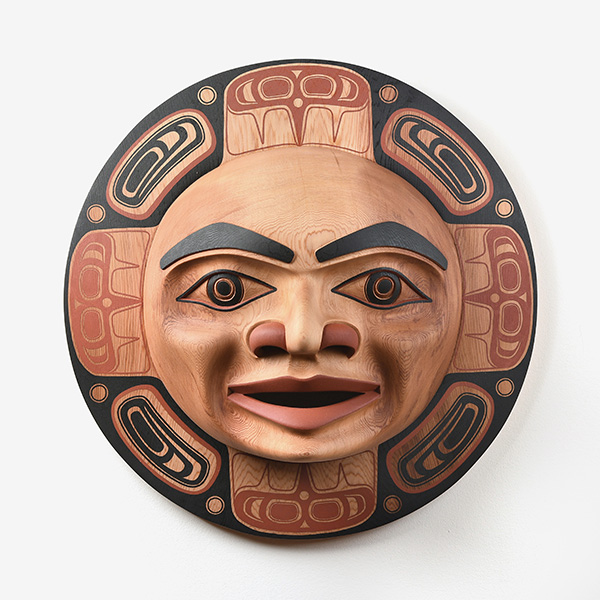
- Engage with Us
Explore the Collection
- Enrich your Mind
- Jewelry
- Graphics
Availability: Only 1 available
Yellow Cedar wood, Acrylic paint
CA$1,950.00
Only 1 available
Reserve this artworkYou may choose to reserve an item in consideration of purchase by clicking the "Reserve for Purchase" button (instead of Add to Shopping Cart). This allows you the opportunity to contact our gallery with any inquiries prior to purchase and it will ensure the item continues to be on hold while you are communicating with us.
If you should find an item already on "Reserve" that is of interest to you, please contact us directly at 604.684.9222 or [email protected] and we can provide you with the status of the piece and whether it will become available for purchase again, or if the sale is in progress with a buyer.
One of life’s most rewarding experiences is collecting fine art, and sometimes it’s best to take a little more time to make these acquisitions with ease. We understand and want to do everything possible to make collecting your next artwork more comfortable. At Coastal Peoples Gallery, we offer an interest-free layaway program and offer flexible terms which can be customized to your individual needs.
Yellow Cedar wood, Acrylic paint
| Dimensions | 13.75 x 41 x 3" (34.93 x 104.14 x 7.62cm) |
|---|---|
| Product Number | I-49025 |
| Exhibition Code | CS2023 |

|
|
|---|---|
| Artist | Jim Charlie |
| Nation | Coast Salish (Squamish) Nation |
| Description | Coast Salish (Squamish) Nation Jim Charlie was born September 10th, 1967 on the Capilano Reserve in North Vancouver, British Columbia, Canada. He is a member of the Squamish Nation of the Coast Salish peoples. Squamish territory encompasses much of Greater Vancouver inluding North and West Vancouver, Howe Sound and lands and rivers all the way up to Whistler, BC. Jim comes from a long line of artists; therefore, it was only natural that he began to carve at a young age. Jim is the grandson of Dominique Charlie, who passed on some years ago. He was a highly-regarded carver during his time. He educated Jim on the many stories and legends common to the Salish people and inspired him throughout his years of carving. Jim studied under Phil Janze, a well established Gitksan artist, in order to become more proficient in achieving greater depth and a different perspective of style. Jim has been influenced by many well known artists and strives to achieve the utmost quality in his work. He is a versatile artist who enjoys depicting a variety of legends. His style is refined, uncomplicated, and dimensional with a northern influence. Jim is one of many Northwest Coast Native artists who are working to uphold their cultural traditions through their artwork and craft. |
Hand blown glass, Red Cedar wood base
This beautiful contemporary rattle is made with hand-blown glass, an example of Susan Point’s balance between traditional and contemporary styles. It demonstrates her ability to diversify, yet reveals her respect for tradition and ancient mythology. Based on an ancient implement, a spindle whorl was used for spinning wool into yarn for the process of creating fine woolen blankets.
Spoons and ladles were traditionally made from either cedar wood or the horn of a mountain sheep, and their handles were carved with family crest images. Historically, these exquisitely sculptured objects were primarily created by people in Northern Nations, and were highly sought after by other nations. During potlatches [festive gatherings], cedar ladles decorated with the hosting family’s crests were used to serve food, while the elaborately carved mountain sheep spoons were distributed as gifts among the many guests.
Today, spoon and ladle productions are based on these traditional objects and are meant to be both objects of function and display. In addition to traditional mediums such as cedar wood, goat or mountain sheep horn, many modern-day spoons and ladles are constructed of gold, silver and pewter.
Sterling Silver; Repousse, Engraved
Derek White’s extraordinary Beaver & Eagle Fish Bowl, created in the traditional Haida form and utilizing the ancient technique of repousse to add dimension, demonstrates his articulate master carving and artistry skills. Containers such as bowls were traditionally created out of Cedar or Alder wood and utilized in daily life. The chosen medium of silver serves as a contemporary progression of this ancient art form while illustrating the intricate foundational links which combine cultural heritage with the arts.
Red Cedar wood, Yellow Cedar wood, Acrylic paint
Specific and unique to the Northwest Coast People is the bentwood or bent-corner box or container. A most outstanding item of the First Nations people, it is a made from one single plank of wood through a lengthy steaming process – a method strictly adapted by the coastal peoples.
Red Cedar wood, Acrylic paint
“The design for this piece was inspired by the work of Robert Davidson.” ~ Jim Charlie, 2021
CAD |
$ |
USD |
$ |
EUR |
€ |
GBP |
£ |
AUD |
AU$ |
CHF |
CHF |
NZD |
NZ$ |
JPY |
¥ |
|
CAD
|
USD
|
EUR
|
GBP
|
AUD
|
CHF
|
NZD
|
JPY
|

